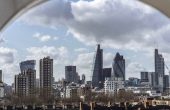After Cicely wrote a brilliant piece about The Definition of Gender for this blog last year, where she looked at the increasing exposure of trans issues in the fashion industry, I thought who better to ask to review the Fashion Space Gallery’s latest exhibition? Having also being involved in the curation of the show, Cicely brings a unique and informed perspective on the ‘Museum’, which she has been kind enough to share here.
Last month, LCF’s Fashion Space Gallery opened ‘Museum of Transology’, an exhibition running until 22nd April. On display are over 120 crowd-sourced objects lent by trans people across the UK, along with hand-written tags accompanying each exhibit, quite literally giving each lender a voice into their experience. It is the largest collection of trans-related artefacts ever to be displayed in the UK, and this precedent in itself makes the exhibition hugely significant in marking how notions around gender are changing.

Swimming goggles. Image via Katy Davies
I was lucky enough to be involved with the organisation of ‘Museum of Transology’, compiling the object list in running order and transcribing each tag, as well as curating the small vitrine sitting outside the gallery. The exhibits range from, among other things, a letter from the Queen, clothing and prosthetics that alter silhouettes, a My Little Pony toy, two jars of breast tissue conserved with formaldehyde, hormones, and a pair of swimming goggles. This seemingly random mix of objects and the stories their owners have written showcase the breadth of the trans experience, taking back control over a perception that has often been directed by what is known as the ‘cisgender-gaze’.

The vitrine curated by Cicely. Image via Katy Davies
This ‘cis gaze’ has often focused disproportionately on the myth of the trans body and what it looks like: frequent ‘before and after’-styled articles setting up a projection of trans people being ‘other’, alien. Whilst altering the body through prosthetics, clothing, or hormones and surgery is undeniably a significant aspect in helping many trans people feel more connected and confident about their gender, for many others this is a contentious socio-political point about ‘passing’. The vast array of objects and the order in which they are organised demonstrates this complex issue brilliantly. Grouped into islands of displays, the exhibition broadens onto other crucial issues such as feminism, intersectionality, language, the importance of clothing in constructing one’s identity regardless of silhouette, and emotional and mental well-being.
Indeed, the hand-written tags contextualise the need for such representation. Some are funny, some reflective, others happy or sad – but all of them moving. One such tag accompanied a pair of cherished children’s ballet shoes – its owner describing how he battled gender stereotypes as people could not believe him to be a boy if he enjoyed ballet.

Ballet shoes. Image via Katy Davies
As in any case, language is central to providing accurate presentation into trans issues. When previously researching this subject, I found that many cis people (myself included) were hesitant to discuss such issues in fear of causing offence due to an uncertainty of appropriate language – the common misuse of pronouns being a good example. Recognising this, the gallery team applied a glossary of relevant terminology and their definitions onto the windows of the gallery. They also included the glossary on the first page of the free booklet at the entrance of the exhibition, allowing for visitors to check and research terms at their discretion and in their own time.
The design of the exhibition imitated a home. A bathroom cabinet, half of a wardrobe and luxurious dresser on the floor at an angle, curtain hangers, a coffee table, and a hat stand on which visitors could attach notes of their own with the same styled tags as the lenders. Indeed, as the gallery is a singular room and the exhibition was not partitioned, the open atmosphere supports this air of homeliness.

The Museum of Transology. Image via Katy Davies
You could speculate what the purpose behind the design is: that these objects and narratives finally have a public home and platform; or marking a hopeful change in the way society shall value transcestry, particularly given that many trans people have experienced social displacement from friends and/or family. One friend commented that, for her, the cabinets symbolised both trans people and the skeletons of the injustices they’ve faced coming out of the closet, leading to better representation in the future. All of these interpretations point towards a feeling of social inclusivity.
One month into its opening, ’Museum of Transology’ has already been incredibly meaningful for many. For many in the trans community, it represents a public platform in which to air their narratives. For many cis visitors, it has provided an insight into the breadth of the trans experience, breaking down the sense of otherness trans people often face. The curator of ‘Museum of Transology’, E-J Scott, is encouraging the collection to be taken on by a museum with a social history remit once the exhibition closes in April. In any case, ‘Museum of Transology’ shall be marked as a vital turning point in the way trans stories are valued in the future.
The Museum of Transology exhibition runs at Fashion Space Gallery until April 22nd. Find out more here.




